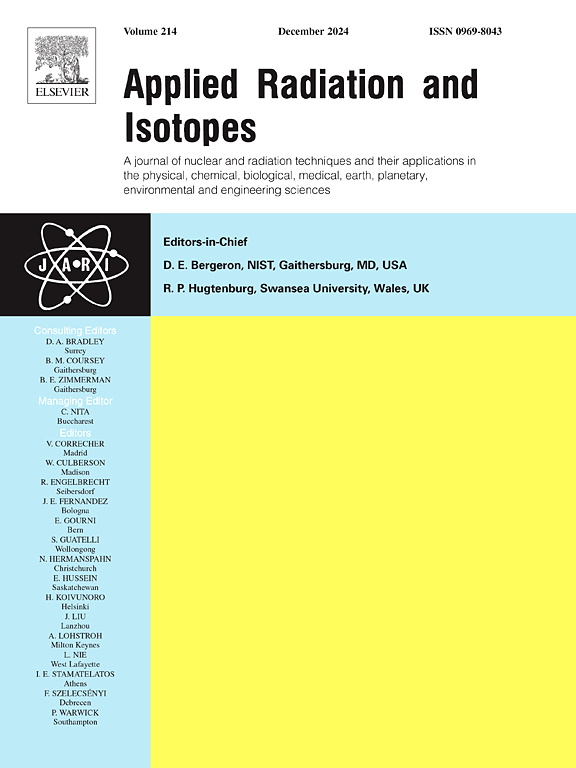伽玛射线辐照种子和叶面施用纳米铜促进干旱土壤中硬粒小麦生长和生产力
IF 1.6
3区 工程技术
Q3 CHEMISTRY, INORGANIC & NUCLEAR
引用次数: 0
摘要
本研究旨在通过γ射线辐照种子和纳米Cu喷施两种策略提高干旱条件下硬粒小麦的产量。在60co γ辐照装置中辐照小麦种子,辐照强度分别为0Gy (R0)、50Gy (R50)、100Gy (R100)、150Gy (R150)和200Gy (R200),同时在实验室制备纳米cu。随后进行了为期2个季节的田间分块设计研究,其中在主地块上施用纳米Cu,即30 (nCu30)、60 (nCu60)和90 mg Cu L−1 (nCu90),而不是推荐的铜矿物质剂量(Cu60),而在子地块上施用辐照种子。结果表明,Cu60处理对小麦生长和产量的促进作用最大。叶面施用nCu60也有相当的增产效果。同样,γ辐照(≤150Gy)也能有效促进小麦的生长和产量。总体而言,小麦生长参数和产量与植株对Cu、N、Fe、Zn和Mn的吸收呈极显著正相关。在这两个因素的组合下,R150nCu90在第一和第二季的产量增幅最高,分别达到4.7和5.5 Mg ha−1。这两个季节的产量都比R0Cu60处理高出20%以上。结果表明,150 Gy γ射线辐照和纳米cu喷雾(nCu60)能提高干旱土壤上小麦的产量。本文章由计算机程序翻译,如有差异,请以英文原文为准。
Enhancing durum wheat growth and productivity in arid soils via seed irradiation with gamma rays and the foliar application of nano Cu
The current study aims at increasing durum wheat productivity under arid-conditions via following two strategies: seed irradiation with γ-rays and spraying plants with nano Cu. Wheat seeds were irradiated in a60Co Gamma Irradiation Unit to achieve 0Gy (R0), 50Gy (R50),100Gy (R100), 150Gy (R150) and 200Gy (R200), while nano Cu-was prepared in lab. A field study of a split-plot design was then conducted for 2-seasons, in which foliar applications with nano-Cu were applied in main plots i.e. 30 (nCu30), 60 (nCu60) and 90 mg Cu L−1 (nCu90) versus the recommended Cu-mineral dose (Cu60) while irradiated seeds were applied in subplots. The obtained results showed that the highest increases in wheat growth and yield were attained for Cu60. Comparable increases in grain yield were noticed for nCu60 foliar application. Likewise, γ-irradiation (≤150Gy) effectively enhanced wheat growth and productivity. Generally, wheat growth parameters and productivity were correlated significantly and positively with plant uptake of Cu, N, Fe, Zn and Mn. Concerning combination between these two factors, the highest increase in grain yield was noted for R150nCu90, recording 4.7 and 5.5 Mg ha−1 in the first and second seasons respectively. These yields were over 20 % higher than R0Cu60 treatment in the two seasons of study. We concluded that seed irradiation with γ-rays up to 150 Gy and nano-Cu spray (nCu60) is guaranteed to increase wheat productivity grown on arid soils.
求助全文
通过发布文献求助,成功后即可免费获取论文全文。
去求助
来源期刊

Applied Radiation and Isotopes
工程技术-核科学技术
CiteScore
3.00
自引率
12.50%
发文量
406
审稿时长
13.5 months
期刊介绍:
Applied Radiation and Isotopes provides a high quality medium for the publication of substantial, original and scientific and technological papers on the development and peaceful application of nuclear, radiation and radionuclide techniques in chemistry, physics, biochemistry, biology, medicine, security, engineering and in the earth, planetary and environmental sciences, all including dosimetry. Nuclear techniques are defined in the broadest sense and both experimental and theoretical papers are welcome. They include the development and use of α- and β-particles, X-rays and γ-rays, neutrons and other nuclear particles and radiations from all sources, including radionuclides, synchrotron sources, cyclotrons and reactors and from the natural environment.
The journal aims to publish papers with significance to an international audience, containing substantial novelty and scientific impact. The Editors reserve the rights to reject, with or without external review, papers that do not meet these criteria.
Papers dealing with radiation processing, i.e., where radiation is used to bring about a biological, chemical or physical change in a material, should be directed to our sister journal Radiation Physics and Chemistry.
 求助内容:
求助内容: 应助结果提醒方式:
应助结果提醒方式:


